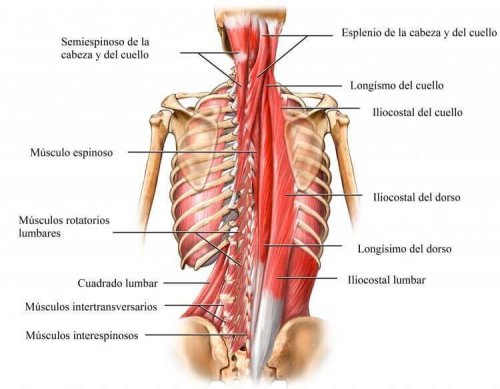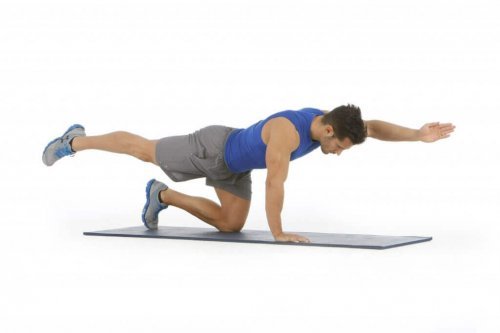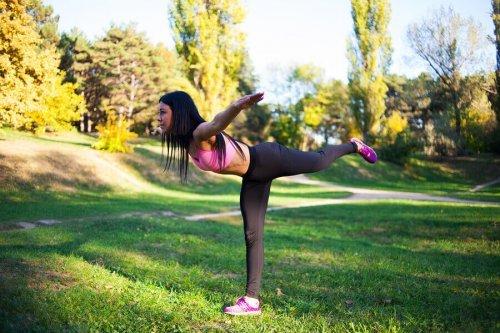Erector Spinae Muscles: Exercises to Strengthen and Stretch

This muscle group is located in the back. It also includes tendons and it’s one of the most important in the body. In the following article, we’ll tell you about the erector spinae muscles, their anatomy, and which exercises will strengthen and stretch them.
What is there to know about the erector spinae muscles?
The erector spinae muscles, also known as the sacrospinal group, are located in the back and extend along the lumbar, cervical, and thoracic regions. They are divided into three parts:
1. Iliocostalis
It originates from the sacrum, the iliac crest, and the aponeurosis. Additionally, it’s subdivided according to its location: lumbar (between ribs twelve and seven), thoracic (from the first six ribs to the last six ribs), and cervical (from the first six ribs to the transverse process).
2. Longissimus
It’s also divided into three zones; according to its origin and insertion: thoracic (begins in the sacrum and inserts into the transverse process), cervical (originates in the T6-T1 vertebrae and inserts into the C7-C2 vertebrae), and the head (starts in the transverse process T4-T1 and advances through the vertebrae C7-C4).
3. Spinalis
Like the other two, it’s subdivided into three sections. These are: thoracic (from L3-T10 to T8-T2), cervical (from T2-C6 to C2-C4), and head (runs along the cervical vertebrae and upper thoracic and inserts into the external occipital protuberance).

The erector spinae muscles also include tendons and combine and extend mostly vertically. This large muscle mass may vary in size and structure depending on the area. For example, in the lumbar region, it’s larger.
Exercises to strengthen the erector spinae muscles
When our back hurts, we often blame it on spending lots of time in front of the computer. However, this may happen because our muscles are somewhat “weak”.
As far as the erector spinae muscles, we also have to consider the fact that they’re responsible for lifting the body when we bow. That’s why it’s so important to stretch and strengthen them. The following exercises can help you with this goal:
1. Bird dog
This is a very good exercise for developing strength in the central part of the body. To do this, put your hands and knees on the floor shoulder-width apart. Raise your right arm and point to the sky with your thumb.
At the same time, lift your left leg and extend it parallel to the ground (as if kicking backward). Stay in this pose in total balance for three seconds. Change sides and perform 10 repetitions per arm.

2. Deadlift
At first, we can perform the deadlift with small dumbells and increase the weight as we gain strength in our arms and erector spinae muscles. To do it, stand up with your back straight, and your legs slightly apart.
Hold the dumbells with your hands and bring your shoulders slightly back. Tilt your torso forward and flex your knees. The point is to lift the full weight of the dumbells with your arms. Hold the position for a few seconds and return very slowly to the starting point. Repeat 12 times.

3. Superman, also effective for training the erector spinae muscles
The third of the exercises for the erector muscles in the spine is done lying on your stomach. Once in that position, put both arms in front of the head and lift them at the same time as the legs (which always remain extended).
The head should be straight, looking down. Don’t lift off beyond the chest from the floor or mat. Hold the position for 10 seconds, put down your arms and legs, and repeat at least eight times.

There’s another version of the Superman exercise, which is performed standing up. How? Put your right hand on a wall, a chair, or a table to maintain balance. Lift your left leg until it’s parallel to the ground and aligned with the spine. Hold for a few seconds and do the same with your left hand and right leg.

With these exercises, you can strengthen and, at the same time, stretch the erector spinae muscles. Thus you will avoid the typical pains in that area. Moreover, you’ll improve your balance, coordination, and, above all, concentration.
This muscle group is located in the back. It also includes tendons and it’s one of the most important in the body. In the following article, we’ll tell you about the erector spinae muscles, their anatomy, and which exercises will strengthen and stretch them.
What is there to know about the erector spinae muscles?
The erector spinae muscles, also known as the sacrospinal group, are located in the back and extend along the lumbar, cervical, and thoracic regions. They are divided into three parts:
1. Iliocostalis
It originates from the sacrum, the iliac crest, and the aponeurosis. Additionally, it’s subdivided according to its location: lumbar (between ribs twelve and seven), thoracic (from the first six ribs to the last six ribs), and cervical (from the first six ribs to the transverse process).
2. Longissimus
It’s also divided into three zones; according to its origin and insertion: thoracic (begins in the sacrum and inserts into the transverse process), cervical (originates in the T6-T1 vertebrae and inserts into the C7-C2 vertebrae), and the head (starts in the transverse process T4-T1 and advances through the vertebrae C7-C4).
3. Spinalis
Like the other two, it’s subdivided into three sections. These are: thoracic (from L3-T10 to T8-T2), cervical (from T2-C6 to C2-C4), and head (runs along the cervical vertebrae and upper thoracic and inserts into the external occipital protuberance).

The erector spinae muscles also include tendons and combine and extend mostly vertically. This large muscle mass may vary in size and structure depending on the area. For example, in the lumbar region, it’s larger.
Exercises to strengthen the erector spinae muscles
When our back hurts, we often blame it on spending lots of time in front of the computer. However, this may happen because our muscles are somewhat “weak”.
As far as the erector spinae muscles, we also have to consider the fact that they’re responsible for lifting the body when we bow. That’s why it’s so important to stretch and strengthen them. The following exercises can help you with this goal:
1. Bird dog
This is a very good exercise for developing strength in the central part of the body. To do this, put your hands and knees on the floor shoulder-width apart. Raise your right arm and point to the sky with your thumb.
At the same time, lift your left leg and extend it parallel to the ground (as if kicking backward). Stay in this pose in total balance for three seconds. Change sides and perform 10 repetitions per arm.

2. Deadlift
At first, we can perform the deadlift with small dumbells and increase the weight as we gain strength in our arms and erector spinae muscles. To do it, stand up with your back straight, and your legs slightly apart.
Hold the dumbells with your hands and bring your shoulders slightly back. Tilt your torso forward and flex your knees. The point is to lift the full weight of the dumbells with your arms. Hold the position for a few seconds and return very slowly to the starting point. Repeat 12 times.

3. Superman, also effective for training the erector spinae muscles
The third of the exercises for the erector muscles in the spine is done lying on your stomach. Once in that position, put both arms in front of the head and lift them at the same time as the legs (which always remain extended).
The head should be straight, looking down. Don’t lift off beyond the chest from the floor or mat. Hold the position for 10 seconds, put down your arms and legs, and repeat at least eight times.

There’s another version of the Superman exercise, which is performed standing up. How? Put your right hand on a wall, a chair, or a table to maintain balance. Lift your left leg until it’s parallel to the ground and aligned with the spine. Hold for a few seconds and do the same with your left hand and right leg.

With these exercises, you can strengthen and, at the same time, stretch the erector spinae muscles. Thus you will avoid the typical pains in that area. Moreover, you’ll improve your balance, coordination, and, above all, concentration.
All cited sources were thoroughly reviewed by our team to ensure their quality, reliability, currency, and validity. The bibliography of this article was considered reliable and of academic or scientific accuracy.
- Caldwell, J. S., McNair, P. J., & Williams, M. (2003). The effects of repetitive motion on lumbar flexion and erector spinae muscle activity in rowers. Clinical Biomechanics. https://doi.org/10.1016/S0268-0033(03)00117-7
This text is provided for informational purposes only and does not replace consultation with a professional. If in doubt, consult your specialist.








